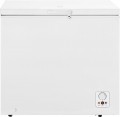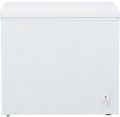Capacity
The total working volume of the freezer compartment. A larger volume allows for more products to be stored, but it affects the size and cost of the unit; therefore, when choosing based on this parameter, it's important not to chase maximum capacity but to consider what volume you actually need. For example, for household use, the average necessary volume is 50 liters per person; and when choosing a display freezer (see "Type"), you need to consider the number of products to be sold. More detailed recommendations for selecting the optimal volume can be found in specialized sources.
It is also worth considering that the freezer is often divided into several compartments (see below) — which means that a large volume does not necessarily guarantee that large pieces of products can fit into the device.
Power failure autonomy
The amount of time the freezer keeps food cold enough when the refrigeration system is turned off, for example, due to a breakdown or power outage. Technically, the power failure autonomy for each model is calculated differently; For example, for a freezer with an operating temperature of -18 ° C, this is the period during which the products in the chamber heat up from -18 ° C to -9 ° C. To sum up, the time is indicated during which the frozen products are guaranteed not to heat up to a temperature at which they could lose their properties.
Freeze capacity
One of the main indicators of freezer performance is the approximate amount of fresh food that the freezer can completely freeze from room temperature to the minimum operating temperature in 24 hours. For domestic use, a power of 10-15 kg/day is considered quite sufficient. More performant models may be required if you have to freeze a lot of food at a time or for industrial purposes.
Lighting
Freezer interior lighting system. This function is very helpful given that the working chamber of the unit, even with the door open, is often shaded, and it is not so easy to see its contents. The lighting usually works automatically — similar to how it is implemented in refrigerators: the light turns on when the door is opened and turns off when it is closed.
Mechanical lock
If a child lock provides for electronic locking of controls, then
mechanical lock is a lock for the door, which can be opened with a key. This solution is in high demand in chest freezers intended for non-domestic use.
Hidden door handle
A handle made in the form of a notch at the end of the door. Thanks to the
hidden handle, the freezer at least gets a neat, discreet appearance — with a minimum of unnecessary details on the doors. In addition, a traditional handle can be touched by careless movement, but with a hidden one, it is impossible. It is especially relevant in cramped conditions.
Energy class
The energy class shows how economical the freezer is in terms of electricity consumption. Initially, the classes were designated in Latin letters from A (most economical) to G (high power consumption). Recently, improved classes A+, A++ and A+++ appeared (the more pluses - the more economical the device).
It should be borne in mind that this indicator represents not the actual energy consumption but the efficiency of the unit compared to similar models. Therefore, a small class A freezer may have a lower power consumption than a large class A++ model. And other things being equal, a more economical device, as a rule, costs more, but this difference can quickly pay off during the operation.
Energy class (new)
This parameter shows the efficiency of electricity consumption by the freezer. Classes are designated in Latin letters from A to G, in ascending order of energy consumption. It was originally conceived until more energy-efficient models pulled up to class A, which eventually received the marking A+, A++, and A+++. Further development of technology has made it possible to go even further and, in order not to produce pluses in energy efficiency labelling, in March 2021, manufacturers returned to the previous indices from G to A, where A is the most energy-efficient freezer. Accordingly, the 2021 models will have modern markings, while older models will be marked the old way.
Energy consumption per year
It is the average amount of energy consumed by the freezer in a year of operation. Of course, these figures are not absolutely accurate. The actual power consumption may vary depending on the specific operating conditions. However, this parameter makes it possible to evaluate the consumption of the device and compare different models with each other. At the same time, it often turns out to be more convenient and visual than the energy consumption class (see above) because, in this paragraph, we are talking about a specific figure (from which you can also calculate the cost of electricity consumed).

